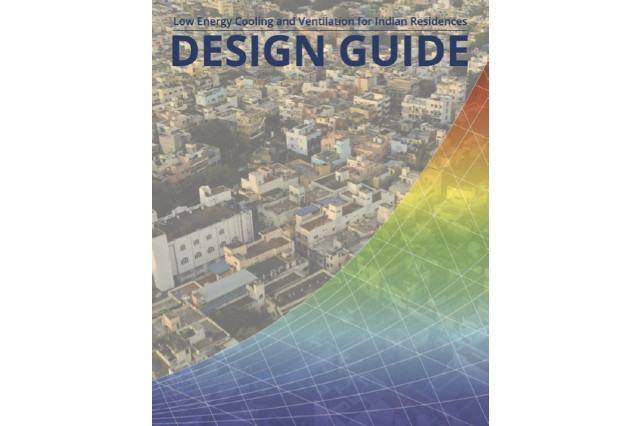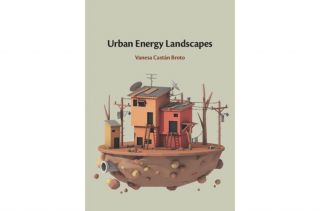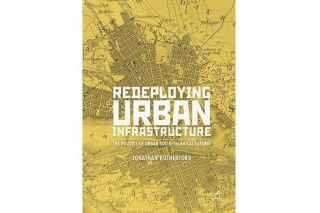
www.buildingsandcities.org/insights/reviews/design-guide-low-energy-cooling-indian-residences.html
Design Guide to Low Energy Cooling and Ventilation for Indian Residences

By Malcolm Cook, Yash Shukla, Rajan Rawal, Dennis Loveday, Luciano Caruggi de Faria and Charalampos Angelopoulos. 2020, Published by Centre for Advanced Research in Building Science and Energy, CEPT University, ISBN: 9781838031008.
Peter Graham (Global
Buildings Performance Network) explains how this new design guide can make a large
contribution to mitigating climate change and reduce electricity demand. Good
design and adaptive behaviours can significantly reduce dependency on air
conditioning in India's new apartment buildings.
Despite our best efforts at improving building energy
efficiency, total energy demand and associated emissions continues to grow. The
buildings sector's global energy-related emissions have risen 7% since 2010 (Global
Alliance on Buildings and Construction et al., 2019), driven by urbanisation,
new construction, increasing demand for electricity and inefficient cooling
(International Energy Agency, 2017). The GHG emissions curve in the buildings
sector continues upward.
To meet the GHG reductions recommended by the IPCC (2018), global building sector emissions must reduce by 8% per year and current rates of energy efficiency improvements must double. India is projected to have the largest growth in new construction globally after 2030 adding more than 25 billion m2 of floor area (GABC et al., 2019), and the second largest growth in cooling energy demand between now and 2050. Reducing the growth in the energy demand of India's building sector is therefore globally significant, offering more than 8% of global building energy-related greenhouse gas (GHG) mitigation potential (Ürge-Vorstaz et al, 2012). About 90% of this mitigation potential is related to achieving energy savings in new buildings (Diddi, 2017).
About 70% of the growth in building energy demand in India is driven by the residential sector. Unchecked, it is possible that Indian residences could drive an eight- fold increase in residential building energy demand by 2030. Ensuring new residential construction is as energy efficient as possible could reduce increased demand for energy 5-fold (Rawal & Shukla, 2014). Achieving this outcome requires a reduction in the dependency on air conditioning to provide thermal comfort.
Air conditioning provides a crutch for poor climatic design and makes living in dense, homogenous high-rise buildings possible if there is a reliable electricity supply. However, increased electricity demand due to home air conditioners has outpaced electricity supply in many countries, leading to greater peak electricity demand in hot weather and increased risk of power supply interruptions. Climate change is increasing the frequency and duration of heatwaves, further increasing the vulnerability of power supply. In turn, this creates a human vulnerability if buildings cannot provide thermal adequacy without air conditioning.
A fundamental solution is designing apartments to enable
people to maintain their thermal adequacy by adapting their behaviour and
surroundings to changes in their local climate. Inexpensive technologies e.g.
operable windows, external shading, and ceiling fans can be combined with
insulative materials and climatically sensitive floor planning and façade
design to minimise the need for air conditioning. Good design therefore
provides building occupants with a choice of thermal comfort strategies, and
therefore a diversity of options for reducing electricity use and saving money.
A new Design Guide to Low Energy
Cooling and Ventilation for Indian Residences (LECaVIR) (Cook et al.,
2020) is therefore to be applauded. Developed jointly by Loughborough
University in the UK and CEPT University's Centre for Advanced Research in
Building Science and Energy in Ahmedabad, India, this design guide shows that
many of the measures that provide thermal comfort in buildings need not require
electricity at all. As the authors point out "… our basic need for thermal comfort indoors is a main driver of
building energy demand world-wide." A key aim of building designers should
therefore be to "…deliver thermal comfort
to occupants as energy efficiently as possible". The key to achieving this
aim is providing people with choice and agency in adapting their immediate
surroundings to maintain their thermal comfort.
The LECaVIR Guide provides useful step-by-step design
processes for providing natural and mixed-mode ventilation and cooling in
Indian apartment buildings. Following these steps leads to a greater
understanding of the fundamental principles of climatic design, thermal
comfort, and vernacular cooling strategies. It also simplifies and translates
the complex dynamic modelling of adaptive comfort into simple diagrams, and
draws on research into adaptive behaviours and clothing that influence people's
perceived thermal comfort in an Indian cultural context.
The guide is for architects, engineers, building
operators, students and builders. However, it will also prove empowering for
purchasers and investors who will be able to 'read' an apartment design to
determine its likely adaptive thermal capacity, and therefore their ability to maintain
comfort and reduce electricity bills.
It will also contribute to the Global Building Performance Network (GBPN) program being implemented by CEPT and the Alliance for an Energy Efficiency Economy (AEEE) to support affordable housing developers and local governments in implementing the Energy Conservation Building Code for Residences (ECBC-R). The ECBC-R was launched in December 2018 and will take time to be fully adopted by Indian States and to be effectively implemented in building projects. The power of a well-written design guide is that it can be applied immediately. When aligned with policy goals, design guides can extend regulatory and voluntary performance standards, and contribute to capacity building in local markets.
In the first months of this year, the world has been overrun by the COVID-19 pandemic. The most effective public health strategy for slowing the spread of the virus and saving lives has been to restrict travel, close venues where crowds can gather, and stay at home. The importance of having safe, healthy shelter has become critically obvious to all of us. Yet the survival strategies of staying and working from home, schooling our children online, even washing hands and maintaining a safe 'social distance' rely on the commodities and qualities of space and infrastructure that are accessible only by the most privileged. People in many parts of the world are disadvantaged by lack of access to electricity supply.
The unprecedented scale of the current 'lock-down' has also brought the construction industry to a standstill. The drivers of buildings sector emissions growth - new construction, increasing household income, demand for electricity are momentarily suppressed. This pause in construction activity gives the supply side (developers, practitioners, builders, estate agents, etc) a once-in-a generation opportunity to ensure our social and economic recovery is aligned with the necessity of reducing GHG emissions and energy demand while protecting the health and well-being of us all. It is a unique opportunity to gather and consolidate our knowledge and skills (based on tools, guidelines and training) to change our practices. Guides such as the LECaVIR make an important contribution by showing in practical terms how good climatic design affords comfort in the home as a right rather than as a privilege.
References
Cook, M., Shulka,
Y., Rawal, R., Loveday, D., de Faria, L., Angelopoulos, C. (2020). Low
Energy Cooling and Ventilation in Indian Residences Design Guide. CEPT
Research & Development Foundation & Loughborough University. http://carbse.org/reports-and-articles/
Diddi, S. (2017). Scenarios of energy conservation building code (ECBC) in India. Bureau of Energy Efficiency Presentation. Powerpoint presentation. Retrieved from http://ace-e2.eu/wp-content/uploads/2017/10/S1-P1_Saurabh_Scenario-of-ECBC-in-India.pdf
Global Alliance for Buildings and Construction, International Energy Agency and the United Nations Environment Programme. (2019). 2019 Global Status Report for Buildings and Construction: Towards a Zero-emission, Efficient and Resilient Buildings and Construction Sector. Paris: UNEP. https://globalabc.org/sites/default/files/2020-03/GSR2019.pdf
International
Energy Agency. (2017).Energy Technology Perspectives http://dx.doi.org/10.1787/energy_tech-2017-en
IPCC. (2018). Global Warming of 1.5°C. An IPCC Special Report on the impacts of global warming of 1.5°C above pre-industrial levels and related global greenhouse gas emission pathways, in the context of strengthening the global response to the threat of climate change, sustainable development, and efforts to eradicate poverty. [V. Masson-Delmotte, P. Zhai, H.-O. Pörtner, D. Roberts, J. Skea, P.R. Shukla, A. Pirani, W. Moufouma-Okia, C. Péan, R. Pidcock, S. Connors, J.B.R. Matthews, Y. Chen, X. Zhou, M.I. Gomis, E. Lonnoy, T. Maycock, M. Tignor, and T. Waterfield (eds.)]. Geneva: Intergovernmental Panel on Climate Change.https://www.ipcc.ch/sr15/
Rawal, R. & Shukla, Y. (2014) Residential Buildings in India: Energy Use Projections and Savings. Paris: Global Building Performance Network. https://www.gbpn.org/reports/residential-buildings-india-energy-use-projections-and-savings-potentials-0
Ürge-Vorsatz, D., Petrichenko, K., Antal, M., Staniec, M., Labelle,M., Ozden, E., Labzin, E. (2012). Best Practice Policies for Low Energy and Carbon Buildings. A Scenario Analysis. Research report prepared by the Center for Climate Change and Sustainable Policy (3CSEP) for the Global Buildings Performance Network. https://www.gbpn.org/reports/best-practice-policies-low-carbon-energy-buildings-based-scenario-analysis
Latest Peer-Reviewed Journal Content
A framework for 1.5°C-aligned GHG budgets in architecture
G Betti, I Spaar, D Bachmann, A Jerosch-Herold, E Kühner, R Yang, K Avhad & S Sinning
Net zero retrofit of the building stock [editorial]
D Godoy-Shimizu & P Steadman
Co-learning in living labs: nurturing civic agency and resilience
A Belfield
The importance of multi-roles and code-switching in living labs
H Noller & A Tarik
Researchers’ shifting roles in living labs for knowledge co-production
C-C Dobre & G Faldi
Increasing civic resilience in urban living labs: city authorities’ roles
E Alatalo, M Laine & M Kyrönviita
Co-curation as civic practice in community engagement
Z Li, M Sunikka-Blank, R Purohit & F Samuel
Preserving buildings: emission reductions from circular economy strategies in Austria
N Alaux, V Kulmer, J Vogel & A Passer
Urban living labs: relationality between institutions and local circularity
P Palo, M Adelfio, J Lundin & E Brandão
Living labs: epistemic modelling, temporariness and land value
J Clossick, T Khonsari & U Steven
Co-creating interventions to prevent mosquito-borne disease transmission in hospitals
O Sloan Wood, E Lupenza, D M Agnello, J B Knudsen, M Msellem, K L Schiøler & F Saleh
Circularity at the neighbourhood scale: co-creative living lab lessons
J Honsa, A Versele, T Van de Kerckhove & C Piccardo
Positive energy districts and energy communities: how living labs create value
E Malakhatka, O Shafqat, A Sandoff & L Thuvander
Built environment governance and professionalism: the end of laissez-faire (again)
S Foxell
Co-creating justice in housing energy transitions through energy living labs
D Ricci, C Leiwakabessy, S van Wieringen, P de Koning & T Konstantinou
HVAC characterisation of existing Canadian buildings for decarbonisation retrofit identification
J Adebisi & J J McArthur
Simulation and the building performance gap [editorial]
M Donn
Developing criteria for effective building-sector commitments in nationally determined contributions
P Graham, K McFarlane & M Taheri
Reimagining circularity: actions for optimising the use of existing buildings
R Lundgren, R Kyrö, S Toivonen & L Tähtinen
Effective interdisciplinary stakeholder engagement in net zero building design
S Vakeva-Baird, F Tahmasebi, JJ Williams & D Mumovic
Metrics for building component disassembly potential: a practical framework
H Järvelä, A Lehto, T Pirilä & M Kuittinen
The unfitness of dwellings: why spatial and conceptual boundaries matter
E Nisonen, D Milián Bernal & S Pelsmakers
Environmental variables and air quality: implications for planning and public health
H Itzhak-Ben-Shalom, T Saroglou, V Multanen, A Vanunu, A Karnieli, D Katoshevski, N Davidovitch & I A Meir
Exploring diverse drivers behind hybrid heating solutions
S Kilpeläinen, S Pelsmakers, R Castaño-Rosa & M-S Miettinen
Urban rooms and the expanded ecology of urban living labs
E Akbil & C Butterworth
Living with extreme heat: perceptions and experiences
L King & C Demski
A systemic decision-making model for energy retrofits
C Schünemann, M Dshemuchadse & S Scherbaum
Modelling site-specific outdoor temperature for buildings in urban environments
K Cebrat, J Narożny, M Baborska-Narożny & M Smektała
Understanding shading through home-use experience, measurement and modelling
M Baborska-Narożny, K Bandurski, & M Grudzińska
Building performance simulation for sensemaking in architectural pedagogy
M Bohm
Beyond the building: governance challenges in social housing retrofit
H Charles
Heat stress in social housing districts: tree cover–built form interaction
C Lopez-Ordoñez, E Garcia-Nevado, H Coch & M Morganti
An observational analysis of shade-related pedestrian activity
M Levenson, D Pearlmutter & O Aleksandrowicz
Learning to sail a building: a people-first approach to retrofit
B Bordass, R Pender, K Steele & A Graham
Market transformations: gas conversion as a blueprint for net zero retrofit
A Gillich
Resistance against zero-emission neighbourhood infrastructuring: key lessons from Norway
T Berker & R Woods
Megatrends and weak signals shaping future real estate
S Toivonen
A strategic niche management framework to scale deep energy retrofits
T H King & M Jemtrud
Generative AI: reconfiguring supervision and doctoral research
P Boyd & D Harding
Exploring interactions between shading and view using visual difference prediction
S Wasilewski & M Andersen
How urban green infrastructure contributes to carbon neutrality [briefing note]
R Hautamäki, L Kulmala, M Ariluoma & L Järvi
Implementing and operating net zero buildings in South Africa
R Terblanche, C May & J Steward
Quantifying inter-dwelling air exchanges during fan pressurisation tests
D Glew, F Thomas, D Miles-Shenton & J Parker
Western Asian and Northern African residential building stocks: archetype analysis
S Akin, A Eghbali, C Nwagwu & E Hertwich
Join Our Community

The most important part of any journal is our people – readers, authors, reviewers, editorial board members and editors. You are cordially invited to join our community by joining our mailing list. We send out occasional emails about the journal – calls for papers, special issues, events and more.
We will not share your email with third parties. Read more



Latest Commentaries
COP30 Report
Matti Kuittinen (Aalto University) reflects on his experience of attending the 2025 UN Conference of the Parties in Belém, Brazil. The roadmaps and commitments failed to deliver the objectives of the 2025 Paris Agreement. However, 2 countries - Japan and Senegal - announced they are creating roadmaps to decarbonise their buildings. An international group of government ministers put housing on the agenda - specifying the need for reduced carbon and energy use along with affordability, quality and climate resilience.
Building-Related Research: New Context, New Challenges
Raymond J. Cole (University of British Columbia) reflects on the key challenges raised in the 34 commissioned essays for Buildings & Cities 5th anniversary. Not only are key research issues identified, but the consequences of changing contexts for conducting research and tailoring its influence on society are highlighted as key areas of action.